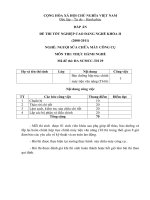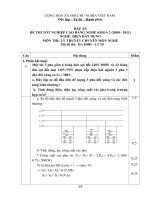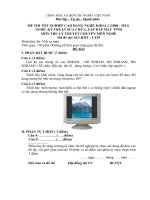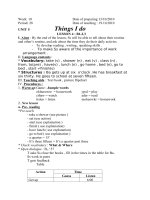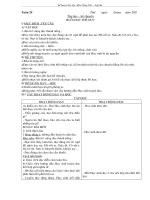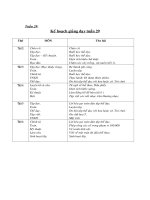PASSAGE 29
Bạn đang xem bản rút gọn của tài liệu. Xem và tải ngay bản đầy đủ của tài liệu tại đây (45.2 KB, 4 trang )
PASSAGE 29
Urbanization is a result of a number of factors and deeper analysis will be required to determine
causality and a more direct correlation between urbanization drivers and population projection. However,
several drivers and factors stand out immediately. These drivers differ in some respects due to the unique
regional, geographic and cultural nuances in various parts of the world, as well as the level of
development and economic maturity, which also influence the specific shape of migration patterns
Regardless of these differences, the urbanization trend is global and many of the drivers seem to be
common across regions and development levels.
One obvious driver is the agricultural revolution and increasing mechanization, automation and
innovation in the agriculture sector. Sophisticated agriculture methods and machinery decrease the
number of workers required to sustain agricultural production. This currently drives a greater velocity of
migration in developing nations that are just now transitioning to more efficient and mechanized
agriculture techniques.
Another driver is the shape of modern economies, specifically the increasing concentration of wealth
creation and the specialized nature of modern workforces. When wealth is concentrated in smaller groups
and more occupations revolve around products and services that support these centers of wealth creation,
there is a natural pull towards those centers. The specialized nature of jobs in the knowledge economy
drives urbanization because hyper-specialization relies on a broader network of interconnected specialists
to support the whole. Moreover, the increasing concentration of industry expertise and wealth into
specific cities is also driving people towards fewer, larger cities in the United States and other developed
economies.
A multitude of other factors drive urbanization. Lifestyle preferences and attitudes matter, such as in ne
shift of baby boomers back into cities in the United States. Opportunities matter, as cities facilitate wealth
creation via scale, network effects, productivity and efficiency gains realized in recent years. Technology
also matters, as new technologies facilitate and improve the urban living experience.
At a high level, it is important to note that none of these factors appear to be temporary; they are all
likely to continue to exert pressure on people to move to cities. The world has been and will continue to
urbanize, leading us to examine the structural pressures and changes that this theme creates on global
systems.
Question 1. What does the passage mainly discuss?
A. The advantages and disadvantages of urbanization.
B. The drivers of urbanization.
C. Urbanization around the world: facts and figures.
D. The relation between urbanization and economic growth
Question 2. The word "migration” in paragraph 2 is most nearly the same as_________
A. employment
B. lifestyle
C. movement
D. work to be
Question 3. According to paragraph 1, which of the following is true?
A. Different regions have completely different causes of urbanization.
B. Different regions have some causes of urbanization in common.
C. Researchers haven't been able to determine the factors leading to urbanization.
D. Countries which experienced urbanization stay in the same level of development.
Page 1
Question 4. Which of the following is not mentioned as a cause of urbanization?
A. The beautiful urban landscapes
B. The development of technology in agriculture.
C. The living patterns in cities.
D. The change in economies and job opportunities.
Question 5. The phrase “relies on” in paragraph 3 is closest in meaning to
A. depends on
B. encourages
C. results from
D. establishes
Question 6. The author's main purpose in paragraph 4 is to:
A. Giving some examples of the causes of urbanization.
B. Summarize three main causes of urbanization mentioned in previous paragraphs.
C. Display other factors leading to urbanization
D. Suggest solutions to slow down the rate of urbanization.
Question 7. What is the author's tone in the passages?
A. objective
B. humorous
C. sarcastic
D. arrogant
ĐÁP ÁN
1-B
2-C
6-C
7-A
3-B
4-D
5-A
LỜI GIẢI CHI TIẾT
Question 1:
Đoạn văn chủ yếu thảo luận về vấn đề gì?
A. Những lợi thế và bất lợi của đơ thị hóa.
B. Q trình điều khiển của đơ thị hóa.
C. Đơ thị hóa trên tồn thế giới: sự kiện và số liệu.
D. Mối quan hệ giữa đô thị hóa và tăng trưởng kinh tế
=> Dẫn chứng: These drivers differ in some respects due to the unique regional, geographic and cultural
nuances in various parts of the world, as well as the level of development and economic maturity, which
also influence the specific shape of migration patterns.
Dịch; Các trình điều khiển này khác nhau ở một số khía cạnh do các sắc thái khu vực, địa lý và văn hóa
độc đáo ở nhiều nơi trên thế giới, cũng như mức độ phát triển và trưởng thành kinh tế, cũng ảnh hưởng
đến hình dạng cụ thể của mơ hình di cư.
Question 2:
Từ "migration” trong đoạn 2 gần giống như từ ___
A. việc làm
B. lối sống
C. sự chuyển động
D. làm việc để được
=> Dẫn chứng: This currently drives a greater velocity of migration in developing nations that are just
now transitioning to more efficient and mechanized agriculture techniques.
Dịch: Việc thúc đẩy tốc độ di cư lớn hơn hiện nay ở các quốc gia đang phát triển hiện đang chuyển sang
các kỹ thuật nông nghiệp hiệu quả và cơ giới hóa hơn.
Page 2
Question 3:
Theo đoạn 1, điều nào sau đây là đúng?
A. Các vùng khác nhau có ngun nhân đơ thị hóa hồn tồn khác nhau.
B. Các khu vực khác nhau có một số ngun nhân của đơ thị hóa.
C. Các nhà nghiên cứu chưa thể xác định các yếu tố dẫn đến đơ thị hóa.
D. Các quốc gia có kinh nghiệm đơ thị hóa vẫn ở cùng mức độ phát triển.
=> Dẫn chứng: These drivers differ in some respects due to the unique regional, geographic and cultural
nuances in various parts of the world, as well as the level of development and economic maturity, which
also influence the specific shape of migration patterns
Dịch: Các yếu tố khác nhau ở một số khía cạnh do các sắc thái khu vực, địa lý và văn hóa độc đáo ở
nhiều nơi trên thế giới, cũng như mức độ phát triển và trưởng thành kinh tế, cũng ảnh hưởng đến hình
dạng cụ thể của mơ hình di cư
Question 4:
Điều nào sau đây không được đề cập là một ngun nhân của đơ thị hóa?
A. Sự thay đổi trong nền kinh tế và cơ hội việc làm.
B. Sự phát triển của công nghệ trong nông nghiệp.
C. Các kiểu sống ở thành phố.
D. Những cảnh quan đô thị tuyệt đẹp
=> Dẫn chứng: (A) Another driver is the shape of modern economies, specifically the increasing
concentration of wealth creation and the specialized nature of modern workforces.
(B) One obvious driver is the agricultural revolution and increasing mechanization, automation and
innovation in the agriculture sector.
(C) A multitude of other factors drive urbanization. Lifestyle preferences and attitudes matter, such as in
ne shift of baby boomers back into cities in the United States.
Dịch: (A) Một động lực khác là hình dạng của các nền kinh tế hiện đại, cụ thể là sự tập trung ngày càng
tăng của sự tạo ra của cải và bản chất chuyên biệt của lực lượng lao động hiện đại.
(B) Một động lực rõ ràng là cuộc cách mạng nông nghiệp và gia tăng cơ giới hóa, tự động hóa và đổi mới
trong lĩnh vực nông nghiệp.
(C) Vô số các yếu tố khác thúc đẩy đơ thị hóa. Các sở thích và thái độ về lối sống, chẳng hạn như sự thay
đổi của những người bùng nổ trẻ em trở lại các thành phố ở Hoa Kỳ.
Question 5:
Cụm từ “relies on” trong đoạn 3 có nghĩa gần nhất với A. phụ thuộc vào
B. khuyến khích
C. kết quả từ
D. thành lập
=> relies on (dựa vào)= depends on (phụ thuộc vào)
Question 6:
Mục đích chính của tác giả trong đoạn 4 là:
A. Đưa ra một số ví dụ về ngun nhân của đơ thị hóa.
B. Tóm tắt ba ngun nhân chính của đơ thị hóa được đề cập trong các đoạn trước.
C. Hiển thị các yếu tố khác dẫn đến đơ thị hóa
D. Đề xuất các giải pháp để làm chậm tốc độ đô thị hóa.
Page 3
=> Dẫn chứng: A multitude of other factors drive urbanization. Lifestyle preferences and attitudes matter,
such as in ne shift of baby boomers back into cities in the United States.
Dịch: Vô số các yếu tố khác thúc đẩy đơ thị hóa. Các sở thích và thái độ về lối sống, chẳng hạn như sự
thay đổi của những người bùng nổ trẻ em trở lại các thành phố ở Hoa Kỳ.
Question 7:
Giọng văn của tác giả trong đoạn văn là gì?
A. khách quan
B. hài hước
C. mỉa mai
D. kiêu ngạo
Page 4
